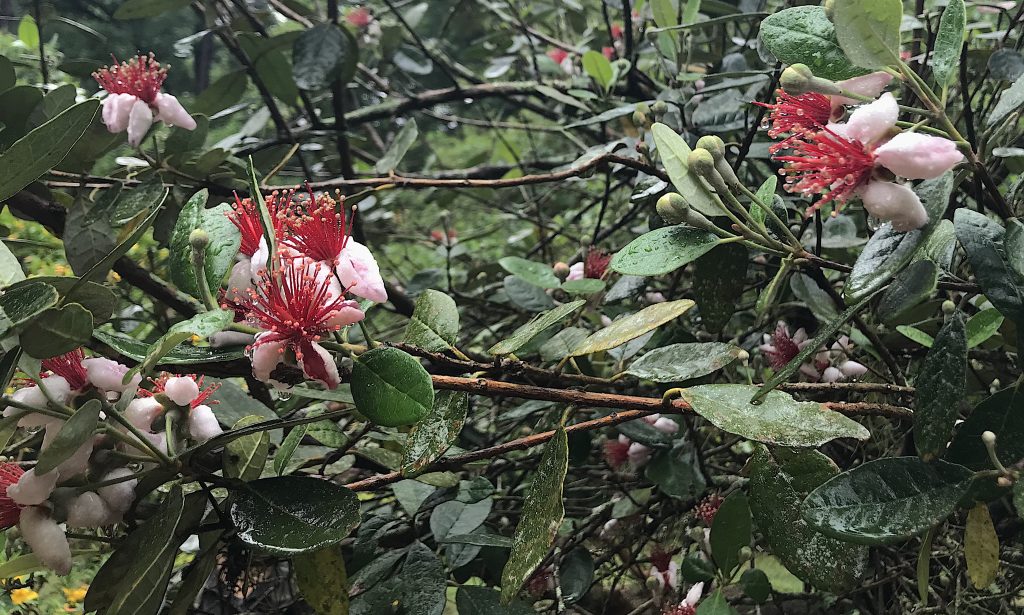
Pineapple guava blossoms are edible, the petals are better than the rest. Photo by Green Deane
Perhaps no ornamental has been championed as much as the Pineapple Guava, aka Feijoa, Acca sellowiana, Feijoa sellowiana. However the perfect shrub for many places never really caught on. There could be several reasons. It probably didn’t help that the Strawberry Guava is a severe invasive species in some locations. The shrub also does not get showy. You have to hunt for the extroverted blossoms. While the entire blossom is edible most people only eat the petals. Five or six months from now they will be dark green fruit that stay green as they ripen. They just get softer. The shrub is easy to identify when in blossom. To read more about both guavas, go here.
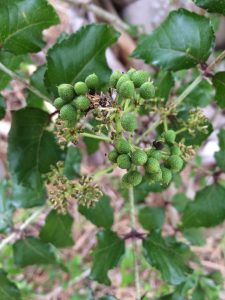
Seed shells make a perfumey peppery. Photo by Green Deane
A couple of hundred miles can make a botanical difference. In Melbourne, some 20 miles south of the space center, we saw a Toothache tree, Zanthoxylum clava-herculis, setting fruit. In Ocala the same species was getting ready to blossom or had a few here and there. Also called Hercule’s Club, the thorns, bark and leaves have been used at least for centuries to numb aching teeth. It will also make you drool, a small inconvenience to silence an aching tooth. You can read about it here. Many Americans have actually eaten part of a relative of the Toothache Tree, Pepper, Zanthoxylum simulans (and Z. bungeanum.) That spice is made from the seeds hulls of the species. We can use the seed hulls of our tree as well. The tree is covered with thorns so approach with care (And another thorny tree seen this recently was Aralia spinosa, which is not related but is sometimes also called Hercules Club.)
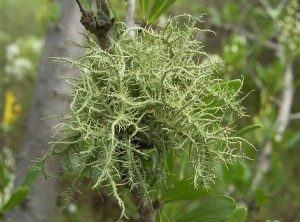
Usnea is an antiseptic on a tree. Photo by Green Deane
Almost all lichen are edible once leached of their bitter acids. The flavor ranges from bad to almost palatable. But, they are high in calories, have saved many a stranded hunter or downed pilot, and are found nearly worldwide. Lichens have been used in dyes, deodorants, laxatives, expectorants, tonics, and as one monograph put it, “healing pastes.” They are also an indicator of clean air. We’re more interested in Usnea than Ramalina for its medicinal qualities. Usnea is basically an antiseptic. While Ramalina and Usnea resemble each other there are three main differences: The Ramalina’s stems are flatish, Usnea is round; Ramalina does not appear to be hairy, Usnea looks hairy; and only Usnea — among all the many species of lichen, has an elastic, white inner core. If you want to read more about lichen go here, for a video here.
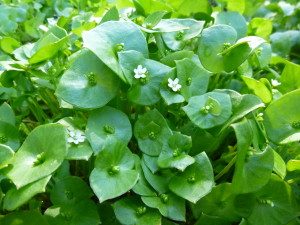
Miner’s Lettuce is not related to pennywort.
Across the country in parts of California Miner’ Lettuce is making its spring run and will be blooming through May. Dry, summer heat ends its season. This delectable comes from a family of other edibles — Claytonia — and was once lumped in with the purslane group. It doesn’t naturally get anywhere near Florida. The most distinctive feature of the Miner’s Lettuce is the leaf structure. Shaped like a saucer or cup the flower stalk pushes through the middle of the upper leaf. Difficult to mis-identify. It’s a resident of western North America with token populations in Georgia and northern New Hampshire. I have been unable to find any reference to it growing in Georgia in modern times. Miner’s Lettuce — which is high in vitamin C — is particularly common along the Pacific coast in shady spots and canyons. Its name comes from 1849 Gold Rush miners who ate it to stave off scurvy.
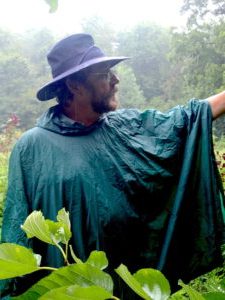
Classes are held rain or shine excepting hurricanes and storm fronts.
Foraging classes range from mid-state to the southwest coast this weekend, just north of Orlando to Port Charlotte.
Saturday, April 24th, Bayshore Park, Bayshore Drive. Port Charlotte. 9 a.m. to noon, meet at the parking loot at the intersection of Bayshore Dive and Ganyard Street.
Sunday, April 25th, Seminole Wekiva Trail, Sanlando Park, 401 West Highland St. Altamonte Springs, Florida 32714. 9 a.m. to noon, meet at the first parking lot on your right after entry.
Saturday, May 1st, Blanchard Park, 10501 Jay Blanchard Trail, Orlando, FL 32817. 9 a.m. to noon, meet at the pavilion next to the tennis courts.
Sunday, May 2nd, Red Bug Slough Preserve, 5200 Beneva Road, Sarasota, FL, 34233. 9 a.m. to noon.
Saturday, May 8th, Mead Garden: 1500 S. Denning Dr., Winter Park, FL 32789. 9 a.m. to noon. Meet by the bathrooms. The entrance to Mead is on Denning not Pennsylvania. Some GPS get it wrong.
For more class information, to sign up or prepay, go here.
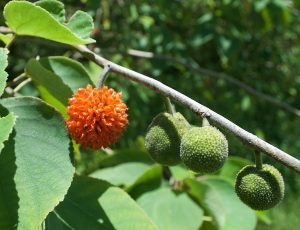
Paper Mulberries are related to bread fruit. Photo by Green Deane
Also nearing fruit is the Paper Mulberry. For many years it was in the same genus as the other mulberries but was farmed out on it’s own. Oddly it is closely related to the Jackfruit, a resemblance that can be seen in the unripe fruit center that looks a small Jackfruit about the size as a large marble. As the name implies the bark of the species was used for thousands of years to make paper and also clothes. It, too, has young leaves that are edible cooked but, like Kudzu, they have a fuzzy texture issue that cooking does not moderate. The core of the mulberry fruit grows a covering of hair that eventually makes the fruit look like a small orange pompom. That’s the part that is edible. Another sidelight of the Paper Mulberry is that its native habitat is a temperate forest. Apparently if it doesn’t get enough chill hours it doesn’t fruit, particularly here in sub-temperate Florida. Paper Mulberry fruit irregularly in the greater Orlando area. It does fruit in Ocala and further north. I have had reports of it fruiting south of mid-state but I have not seen good evidence of said. You can watch a video about it here or read about the Paper Mulberry here.
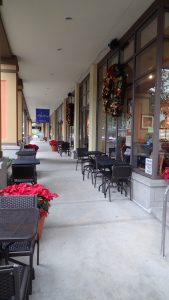
You can forage in a city if you pay attention to some details.
Where do you forage? It’s a question I am asked often and I will provide link to a newsletter three years ago where I explore the topic. The question I was asked this week was more in relation to cities. I am not opposed to foraging downtown and actually hold an annual foraging class in downtown Wointer Park. It only requires a little more attention to detail. The only significant problem with “reclaimed” water is that it is higher in nitrates. The plants grow better. As more plants — other than perhaps the Palmer Amaranth — don’t sequester nitrates plants watered with reclaimed water don’t bother me. Plants in planters don’t bother me if they are maintain. Removing weeds can remove unwanted chemicals. Watered beds above the drainage line of the street or parking lot are usually okay. It is lower areas where run off collects that I do avoid. Here is the link.

Green Deane videos are now available on a USB.
150-video USB would be a good spring present and is now $99. My nine-DVD set of 135 videos has been phased out. The USB videos are the same videos I have on You Tube. Some people like to have their own copy. The USB videos have to be copied to your computer to play. If you want to order the USB go to the DVD/USB order button on the top right of this page. That will take you to an order form. I’d like to thank all of you who ordered the DVD set over the years which required me to burn over 5,000 DVDs individually.

Green Deane Forum
Want to identify a plant? Perhaps you’re looking for a foraging reference? You might have a UFO, an Unidentified Flowering Object, you want identified. On the Green Deane Forum we — including Green Deane and others from around the world — chat about foraging all year. And it’s not just about warm-weather plants or just North American flora. Many nations share common weeds so there’s a lot to talk. There’s also more than weeds. The reference section has information for foraging around the world. There are also articles on food preservation, and forgotten skills from making bows to fermenting food.
Your donations to upgrade the EatTheWeeds website and fund a book were appreciated. A book manuscript has been turned it. It had 423 articles, 1315 plants and a third of a million words. What it will be when the publisher is done with it next year is unknown. Writing it took a significant chunk of time out of my life from which I have still not recovered. (Many things got put off.) The next phase is to update all the content on the website between now and publication date. Also note as it states above the 135-video DVD set has been phased out for 150-video USB. Times and formats change.
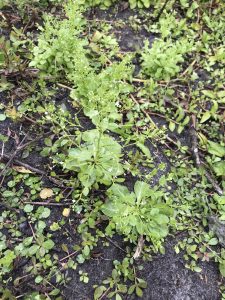
Brookweed grows bitter quickly. Photo by Green Deane
There is an edible species I don’t see often, actually at just one location, Sarasota. It is found throughout most of North America except the high plains states. Brookweed, Samolus valerandi, is an ancient edible plant found throughout most of the world that few know a lot about these days. Even Professor Daniel Austin, who managed to write 909 pages about plants, could only scrape together one paragraph on page 596 of his book Florida Ethnobotany. Brookweed has a history as an edible in Europe (as old books say it is found in the Old and the New World and even in Australia.) It grows in watery conditions and can tolerate some salinity. At least one related species tolerates high salinity. Young leaves are soft, spinach-like. When very young the leaves are bland but quickly develop a bitter flavor, which might explain their absence from the dinner menu but found in the home pharmacy. Like many such greens they were tossed into salads with a lot of other greens. In Catalonia, for example, it is a very common salad addition usually with two to three other greens. When cooked they are used the same way, an addition to not the main flavor of. In parts of Africa it is famine food, that is, eaten when preferred food is not available. It is high in vitamin C.
This is weekly newsletter #454 If you want to subscribe to this free newsletter you can find the sign-up form in the menu at the top of the page.
To donate to the Green Deane Newsletter click here.

